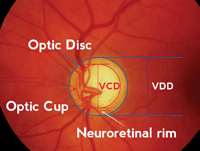 |
| A new screening tool automates
measuring cup-to-disc ratios to provide earlier intervention and treatment |
Used as a screening test, it could allow earlier detection and treatment, the researchers suggest.The computerized analysis measures vertical elongation of the optic cup based on two-dimensional disc images.The program applies analgorithm that divides these images into hundreds of super pixels egments, which are then used to calculate the patient’s cup-to-disc ratio.
“This technique is ready to be used widely, and can be used for screening so that glaucoma can be detected early,” says lead author Jun Cheng, PhD, of the Agency for Science, Technology and Research in Singapore. Early detection allows eye doctors to intervene more promptly and slow disease progression, he adds.
From 2,326 test images, the researchers determined that their automated technique is more accurate than other glaucoma screening methods, such as IOP assessment and visual fields testing.Going forward, Dr. Cheng suggests that integratingother diagnostic information, such as optic cup depth, could further enhance the accuracy of this approach.
Cheng J, Liu J, Xu Y, et al. Superpixel classification based optic disc and optic cup segmentation for glaucoma screening. IEEE Trans Med Imaging. 2013 Jun;32(6):1019-32.

